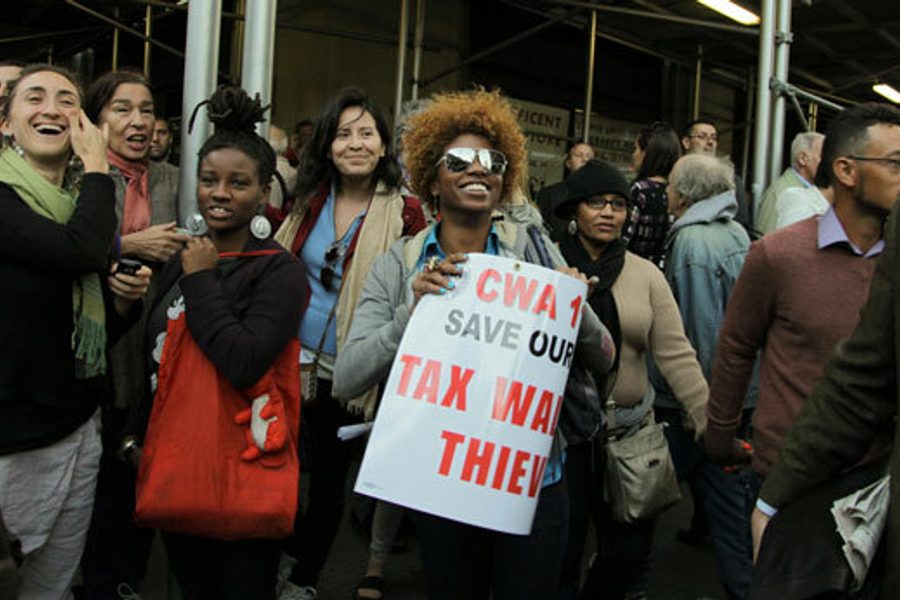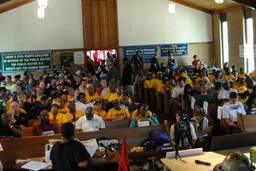Occupy Wall Street Welcomes Solidarity—But Stays Leaderless
In Liberty Plaza Park, unions are one of many groups who can join the struggle against corporatism.
J.A. Myerson

It’s sort of exhilarating not having a leader.
I grew up in a labor household, and that world is definitely not leaderless. At its finest, it is radical and caring and representative and progressive, but there are shots and people whose job it is to call them.
There are no leaders in Liberty Plaza Park. Or, put another way, there are only leaders in Liberty Plaza Park. This makes certain things very difficult – “Whom do I talk to about performing after the GA tomorrow?” “No one. Just announce you’re going to do it.” “How do I make an announcement?” “By talking out loud.” “Where is there to have the performance?” “Wherever you announce you’re going to have it.” – but in more ways, it’s a thrill.
The people who live and work in Liberty Plaza Park have access to food, healthcare, childcare, legal services, a library, warm clothes, sleeping bags, &c. and they don’t have to pay for any of it. They are allowed untrammeled freedom of speech and association, respect afforded to their self-identification, however outside the mainstream, and nothing is expected of them but that they stay non-violent and not do anything to endanger the entire community (like drugs).
There is a natural tension, therefore, when labor unions take public stands in support of the Wall Street occupation and arrange to join it for mass rallies like Wednesday’s.
What, after all, does it mean for hierarchical organizations with troves of public doctrines, manifestos, alliances, endorsements and histories to profess support for a group that has no spokespersons, no chairpersons, no set list of demands, no superstructure and no ideology? What if the General Assembly decides on something that is directly at odds with the stated intentions and principles of the endorsing group? How much of the baggage of the endorsing group is transferred onto the occupation? Reihan Salam, writing for the National Review Online, articulates this tension well.
But there is an answer. Thom Hartmann interviewed Leo Gerard, International President of the United Steelworkers, on his television show Tuesday evening. “It’s very clear that this movement doesn’t need a leadership,” said Gerard. “And so we’re not going to do anything but join with them when they have events… and if they need people to deliver pizzas to them, we’re going to deliver pizzas to them.”
This is just the right tone to take, and frankly the only one many of us on Occupy Wall Street’s Labor Outreach Committee are prepared to accept. It is a clear depiction of the phenomenon that, more than any other, sustains Occupy Wall Street, enlivens it, empowers it: solidarity.
In 2006, Christopher Hayes, in the pages of this publication, outlined “a continuum that ranges from pearl-clutching pity through sympathy and empathy to arrive finally at solidarity, wherein you are propelled to do something for your fellow human beings, to act as if their interests were your own.” That is the basis on which labor unions (whose structural organization clashes with that of Occupy Wall Street) and groups like MoveOn (whose entire political philosophy does) are moved to support the efforts of the campers at Liberty Plaza Park. When solidarity operates, the minutiae of tactical strategy is subject to de-emphasis, and the shared ends take precedence. As the rapper Guru said, “It’s the message in the song that makes you rock on.”
That message is a potent one. “We are the 99%. (And so are you.)” This is not an injunction to unite against the right wing, which is welcome at Liberty, or the cops, with whom the Wall Street occupiers have forged a good rapport, sensationalist reportage notwithstanding. It is an attempt to move beyond these false divisions and work to liberate the steamrolled from the steamrollers – somehow a parallel of the Obama philosophy and its simultaneous negation. If that liberation project is to stand any chance of success, its advocates will have to commit to solidarity, whatever apparent theoretical or organizational conflicts become apparent.
Look, corporatism is a difficult system to dismantle, and the struggle to do so will have to be waged by everyone, the leaderless protest and the well-financed labor union, the online activist community and the people who disrupt sham hearings, the graphic designer and the pundit. For the recent college graduate with no job prospects, saddled with student loan debt until she’s got children of her own in college, the fervor might merely be objecting to the disparity between her circumstances (she having done everything right) and the circumstances confronting the ownership class, whose corruption and mendacity have yielded more wealth and power than ever. (This is the type of person Josh Barro likes to have a go at – how stupid people like that are. Ha ha ha.)
For the more wonkish type, the ardor may spring from a desire to halt the revolving door, to undo the philosophically absurd notions of corporate personhood or political donation as free speech, to limit the outrageous over-financialization of the American economy or to root out regulatory capture (can I get a witness, Tea Party brothers and sisters?).
It means workers having a voice in the workplace and citizens having a voice in their communities. It means exerting pressure on politicians whose primary interlocutors and financiers are committed to the endless accumulation of wealth, notwithstanding any consequent misery. It means energizing an American populace concerned chiefly with celebrities and social networking. It means shifting the focus of a media owned by corporate interests and committed to advancing them. This cannot be done just by top-down or grassroots organization.
It might – just might – get done by a social movement that consists of both.








